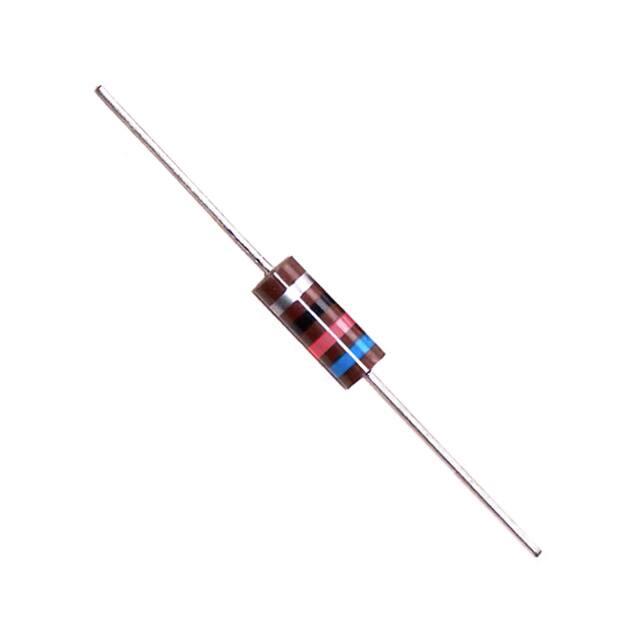1/2 WATT CARBON COMPOSITION
Features:
Low inductance / High Frequency Performance
High Surge / High Pulse Capability
Rugged Construction
Carbon Composition resistors are commonly used in high frequency, fusing, or pulse applications including:
Snubbers
Lightening Surge Protection Circuits
Grounding Resistors
RFI Suppression
Value in
Ohms
10
12
15
18
22
27
33
39
47
56
68
82
100
120
NTE
Stock
Number
HWCC010
HWCC012
HWCC015
HWCC018
HWCC022
HWCC027
HWCC033
HWCC039
HWCC047
HWCC056
HWCC068
HWCC082
HWCC110
HWCC112
NTE
Stock
Number
Value in
Ohms
150
180
220
270
330
390
470
560
680
820
1K
1.2K
1.5K
1.8K
HWCC115
HWCC118
HWCC122
HWCC127
HWCC133
HWCC139
HWCC147
HWCC156
HWCC168
HWCC182
HWCC210
HWCC212
HWCC215
HWCC218
NTE
Stock
Number
Value in
Ohms
2.2K
2.7K
3.3K
3.9K
4.7K
5.6K
6.8K
8.2K
10K
12K
15K
18K
22K
27K
Value in
Ohms
HWCC222
HWCC227
HWCC233
HWCC239
HWCC247
HWCC256
HWCC268
HWCC282
HWCC310
HWCC312
HWCC315
HWCC318
HWCC322
HWCC327
33K
39K
47K
56K
68K
82K
100K
120K
150K
180K
220K
270K
330K
390K
NTE
Stock
Number
NTE
Stock
Number
Value in
Ohms
HWCC333
HWCC339
HWCC347
HWCC356
HWCC368
HWCC382
HWCC410
HWCC412
HWCC415
HWCC418
HWCC422
HWCC427
HWCC433
HWCC439
470K
560K
680K
820K
1M
HWCC447
HWCC456
HWCC468
HWCC482
HWCC510
SPECIFICATIONS
Electrical Characteristics @ 70 C
NTE Number
Resistance Range
(Ohms)
Tolerance
(%)
Voltage
(Volts)
Operating Temperature
(Topr)
HWCC010 thru HWCC382
HWCC410 thru HWCC510
10 to 82K
100K to 1M
10
10
350
350
−55 to +150 C
−55 to +150 C
Temperature Coefficient
(PPM/ C)
0.15%
0.15%
Mechanical* (Typical, inches/mm)
NTE Number
Body Length
(L)
Body Diameter
(D)
HWCC010 thru HWCC510
0.375 (9.53)
0.140 (3.56)
* These dimensions are for reference only, please consult the factory for actual size.
Lead Diameter
(d)
Lead Length
(LL)
0.028 (0.71)
1.000 (25.4)
D
d
LL
L
GENERAL INFORMATION
Pros and Cons of Carbon Composition Resistors
Carbon Composition resistors offer excellent surge and high−frequency performance due to the bulk nature of the resistance element. Unlike wirewound
and film resistors, there are no windings of resistance wire, nor any film depositions to open under overload pulses. Since the resistance element is a hot−
molded solid core comprised of resin and a carbon slug, without helical turns of resistance wire or film, the inductance is extremely low, essentially the same
as a straight piece of wire. The trade−off for the excellent surge and high−frequency capability is a rather unstable environmental performance, particularly
in humid environments, a condition well known by most circuit designers. Carbon composition resistors therefore should not be utilized in precision applications, which are generally better suited by other resistor families such as NTE’s standard Metal Film types.
There is no single resistor family, however, that offers the unique specialty performance levels of the composition construction, but depending on circuit
requirements, other models will often provide a suitable replacement.
16
NTE Electronics, Inc.
Voice (973) 748−5089
FAX (973) 748−6224
http://www.nteinc.com
�1/2 WATT CARBON COMPOSITION
GENERAL INFORMATION (Cont’d)
Moisture / Humidity Considerations
Carbon Composition resistors are not as stable as other types of resistors, especially in higher humidity conditions and therefore not suitable for precision
applications. For example, carbon comps may shift up to 10% during endurance testing. Most general purpose chip resistors have a maximum shift under
the same conditions of less than 3%.
Carbon comps are also highly susceptible to moisture penetration. Damp heat testing may cause carbon comps to shift up to 10%. For that reason, carbon
comps are recommended to be used soon after purchase, especially once the bag is opened. However, even in a sealed poly−bag, carbon comps may
shift up to 5% in a year. Resistance changes due to humidity/ moisture can be positive or negative (mostly positive) and is usually reversible by conditioning
the resistors at 100 −105 C or by dry storage.
Before being considered failures, out−of−tolerance resistors should be conditioned in a dry oven at a temperature of 100 C +5 C for 96 4 hours prior to
conducting resistance measurements, although some customers have had satisfactory results by baking 12−24 hrs at 110 −120 C. Regardless of the
amount of baking, some units may not return to the original value.
Typical levels of shift due to the absorption of moisture is generally less than 10% after 10 days of cycled humidity at 80−100% RH levels. Low and medium−
value composition resistors typically exhibit less change due to humidity than high−value resistors. Parts should be stored in low humidity conditions (45%
RH max). Conditioned (dry) resistors are the most sensitive to humidity.
In operation, moisture absorption is minimized by operating the resistors with as little as 1/8th rated wattage load (the self−heating effect causes parts to
dehumidify).
NTE Electronics, Inc.
Voice (973) 748−5089
FAX (973) 748−6224 http://www.nteinc.com
17
�
很抱歉,暂时无法提供与“HWCC156”相匹配的价格&库存,您可以联系我们找货
免费人工找货